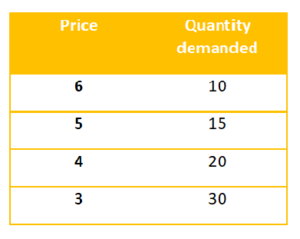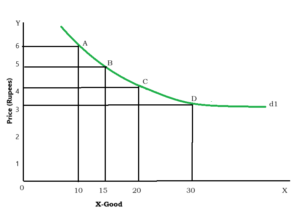Law of Demand
Law of Demand
The relation of price to sales is known in economics as the ‘Law of Demand’. The Law of Demand states that “higher the price, lower the demand, and vice versa, other things remaining the same.”
Definitions
Some popular statements of the Law of Demand are as follows:
- Marshall has stated the Law thus: “the greater the amount to be sold, the smaller must be the price at which it is offered in order that it may find purchasers, or in other words, the amount demanded increases with a fall in price and diminishes with a rise in price.
- In Ferguson’s words, “According to the Law of Demand, the quantity demanded varies inversely with price.”
- According to Bilas, “The Law of Demand states that other things being equal, the quantity demanded per unit of time will be greater, the lower the price and smaller, the higher the price.”
- Samuelson writes “Law of Demand states that people will buy more at lower prices and buy less at higher prices, other things remaining the same.”
The Law of Demand, thus, establishes a definite relation between the price and the quantity demanded. There is, however, no uniform relation between the change in price and the change in the demand for a commodity. The increase in demand may not be exact by in proportion to the fall in price. A fall of one-fifth in the price may increase the sales by a twentieth or it may double them.
Law of Demand can be more conveniently illustrated with the help of a demand schedule and demand curve.
Demand Schedule and Demand Curve
According to Marshall, a demand schedule is a list of prices and quantities. In other words, a demand schedule states the relation between the two variables of price and quantity. We give below an illustration of the ‘Demand Schedule’.
Table: Demand Schedule

It is clear from Table that each price has a unique demand associated with it. As the price of the commodity decreases its demand increases and vice versa.
The Law of Demand or the Price Quantity Relationship’ is also portrayed graphically in the form of a chart called the ‘Demand Curve’. An example of the ‘Demand Curve’ is given in Fig. It is obtained by plotting the data given in Table.

In fig., the curve from point d to d, passing through A, B, C and D is the demand curve. Each point on the demand curve shows one particular price-quantity combination.
Combinations at each point in alphabetical order shows decreasing price of X-goods and increasing number of demand for X-goods. Price-quantity combination in reverse order of alphabets shows increasing price of X-goods and decreasing number for X-goods by an individual.
As Fig. shows, demand curve slopes downward to the right. The downward slope of the demand curve reads the law of demand, i.e., the quantity of a commodity demanded per unit of time increases as its price falls and vice versa.
The price-quantity relation is also expressed algebraically in the form of the following equation:
Q = f (P.)
Which means that quantity demanded is a function of price.
Chief Characteristics of Law of Demand
The chief characteristics of the Law of Demand are as follows:
-
Inverse Relationship:
There is an inverse relationship between the price and the quantity demanded, that is, if the price rises, the demand falls and if the price falls, the demand goes up.
-
The demand is a dependent variable:
Under the law of demand, the price is an independent variable and the demand is a dependent variable. Thus, it is the effect of price on demand, that is examined and not the effect of demand on price.
-
Other things remain the same:
The law of demand assumes that other things remain the same. In other words, there should be no change in other factors influencing demand except price. If, however, any one or more of the other factors, say, income, substitute’s price, consumers’ tastes and preferences, advertising outlays, etc., vary, the demand may rise in spite of a rise in price, or alternatively the demand may fall in spite of a fall in price.
- Important links
- Role and Responsibilities of Business Economist
- Operation of Law of Diminishing Marginal Utility- Causes, Exception
- Law of Diminishing Marginal Utility
- Significance of Business Economics in Decision Making
- Demand and Demand Curve- Explanation & Exception
Disclaimer: wandofknowledge.com is created only for the purpose of education and knowledge. For any queries, disclaimer is requested to kindly contact us. We assure you we will do our best. We do not support piracy. If in any way it violates the law or there is any problem, please mail us on wandofknowledge539@gmail.com
